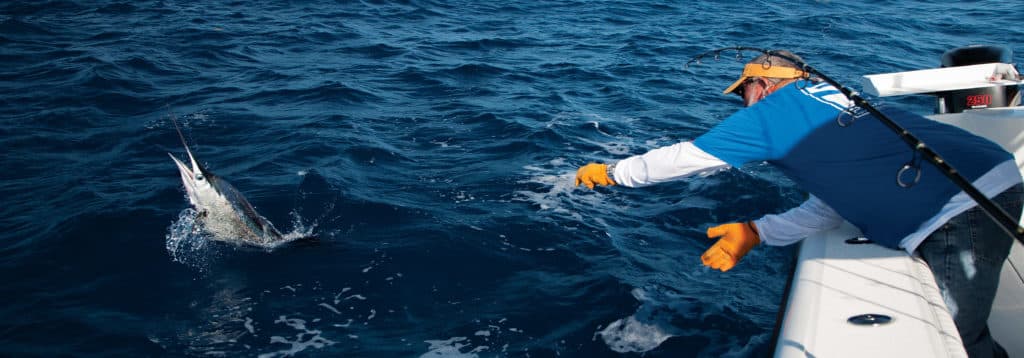
A couple of hours into Day One of the Key Largo Sailfish Challenge, I released my second sailfish of the day, putting our boat total at three. Capt. Randy Towe quickly radioed in the release to tournament director Tammie Gurgiolo to make it official. High numbers are important in sailfish tournaments, but tiebreakers are decided by teams that caught their fish first.
We were sitting squarely in first place, locked into a bite off Conch Reef. Plenty of other boats were squeezed in tightly around us like cattle, but not every boat was catching sailfish.
With the wind coming out of the south and the current heading east, we fished in about 100 feet of water next to a reef wall that started in 45 feet.
This is too easy, I thought as we held the lead over a pack of 10 boats, consisting of 36 different anglers. Until this tournament, I had never competed on a fishing team, even though I’ve been fishing my entire life.
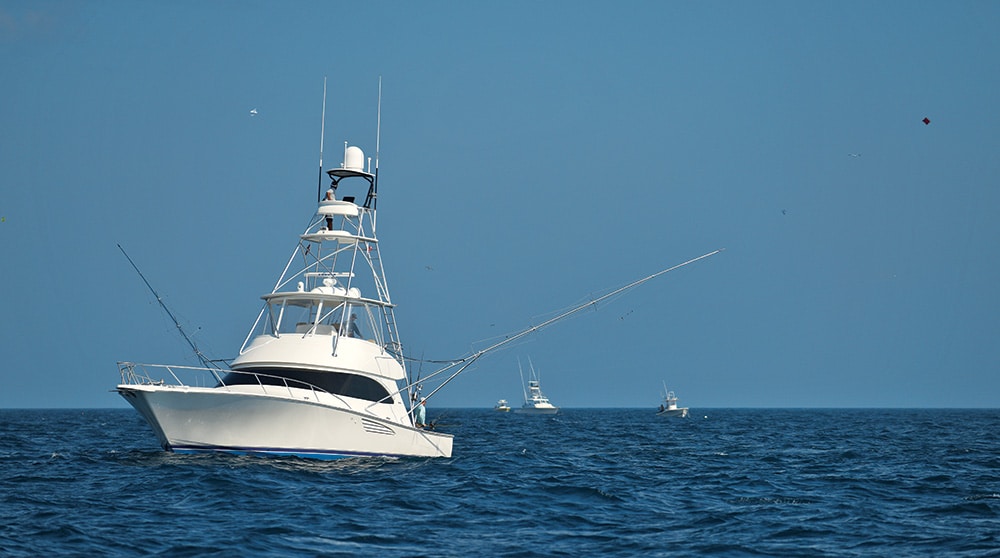
But that was exactly the purpose of this fishing experience: I wanted to dip my feet into the tournament arena to discover what’s necessary to enter the fray and be competitive. Over the course of two days of fishing, I went from jubilation to heartbreak, mixed with tension, adversity and education. Most important, I learned that although tournament fishing isn’t easy, it’s definitely manageable for a dedicated group of anglers willing to put in the time and effort.
Forming a Fishing Team
The night before, early on a January evening, I met my team at Sundowners restaurant in Key Largo for the captains’ meeting, where participants signed up and paid team entry fees. The tournament boat fee for the Sailfish Challenge was $495, including one angler, with each additional angler an additional $450. A bigger fishing team is an advantage overall but also costlier upfront. At the captains’ meeting and dinner, you receive the rules of the tournament. Participants read through the official rules and even brought a copy on the boat to make sure the team is legit all tournament long. One small slip-up can disqualify you from winning, and some tournaments offer hefty purses — from thousands to millions of dollars — for top team finishers.
Towe, a longtime Keys captain and custom rod builder living in Tavernier, served as our “teach coach.” His mate, Capt. Robert “Skinny” Morrison, was his right-hand man on the boat. Joining me as the other angler on our team was Rob Kurz, a longtime charter client of Towe’s who splits time between Philadelphia and Key Largo. It turned out that Kurz was as green to tournament fishing as I was. He’s the owner of a 36-foot Yellowfin, Tall Tales, with triple 300s, and that’s the boat we fished each day.
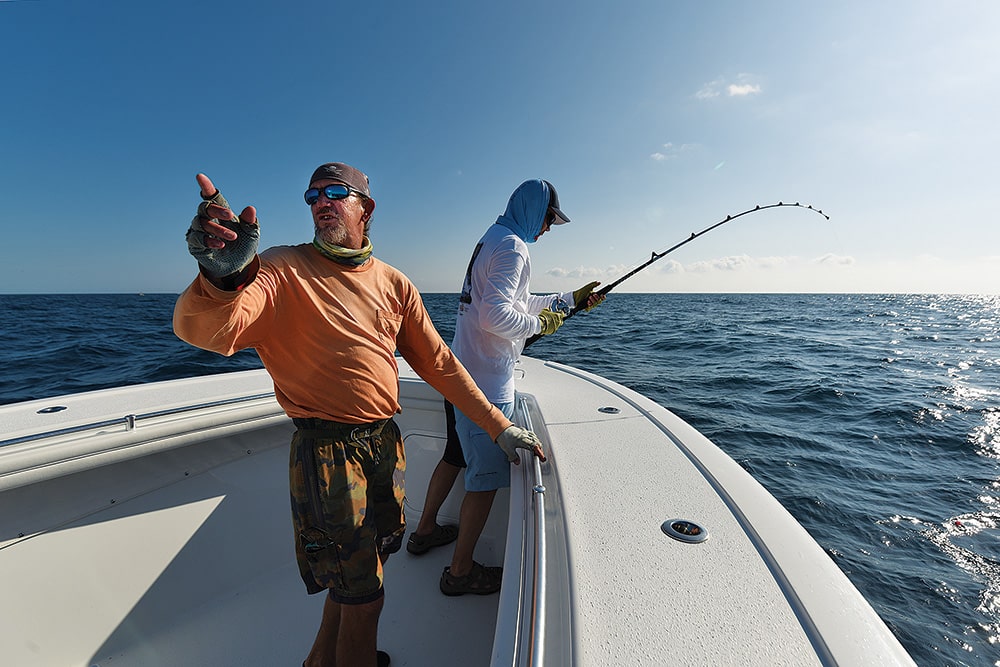
At Sundowners, we checked specific rules that would be important for the next day’s fishing, including lines-in and lines-out times, pound-test max, number of rods allowed, circle-hook usage and even fishing boundaries. For this tournament, the northerly boundary was Pacific Light, with the southerly border Alligator Light. Towe pointed out that he or anyone on the boat could cast a line or set a bait on a kite, but only designated anglers could fight fish to the boat. The Key Largo Sailfish Challenge allows a maximum of six anglers per boat. Nonanglers had to place rods into the rod holders after deploying baits, allowing only anglers to then pick them up once a sailfish struck. IGFA rules filled in the blanks for any question that tournament rules didn’t answer.
To me, this was the best possible scenario for a fishing team. Towe and Morrison are local sailfishing experts. Depending on the winds, currents and water conditions, Towe had a strong understanding of where the sailfish would likely feed. That covered finding fish.
Kurz provided a tournament-worthy boat, along with enough enthusiasm and confidence to enter the tournament. Both Towe and Kurz had the necessary fishing gear, consisting of Fin-Nor Marquesas and Lethals, custom rods and Sufix line to handle likely tournament conditions.
I never could have joined an established fishing team — that’d be like asking to join a NASCAR pit crew. Pro tournament teams practice fishing together, often for months or years. A strong trust is built up among the team so each member knows his exact responsibilities. An angler with little tournament experience would be considered a liability and hindrance. If a rookie angler missed the winning fish, he might be thrown into the ocean and forced to swim home!
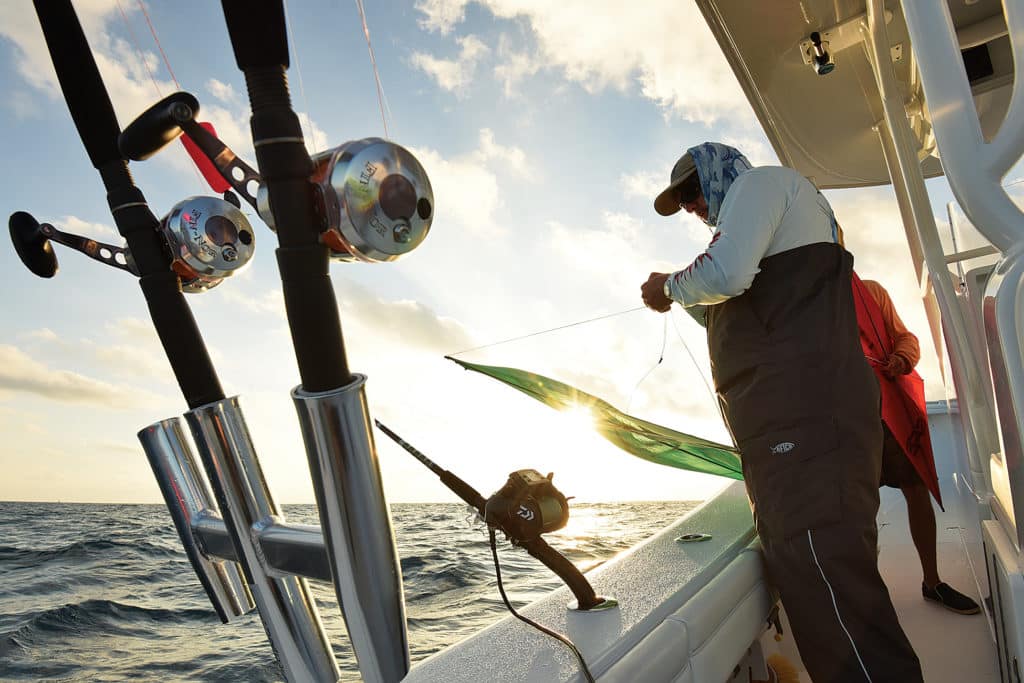
Some fishing teams might not have a coach on the team, like I had with Towe. Instead, it could be a group of friends who fish hard together, or even a group of individuals who invest in a boat with the specific purpose of winning high-dollar tournaments. Pre-fishing practice days before tournaments are sometimes the only opportunity a team has to locate fish. As relaxing as fishing can be, tournament fishing is not for the casual angler.
The Key Largo Sailfish Challenge offered the perfect tournament introduction. Prizes were beautiful pieces of art but not hard cash (besides calcuttas). Calcuttas are an opportunity to score beaucoup bucks from payouts, with prize money generated by entrants or others betting on teams. The tournament itself benefited the Florida Keys Wild Bird Center. So while dedicated teams entered the tournament, those relatively inexperienced tournament fishermen like Kurz and me could still be competitive.
“Pro tournament teams practice fishing together, often for months or years. A strong trust is built up among the team so each member knows his exact responsibilities.”
Some established, well-known tournaments are incredibly competitive, with high entry fees and much larger winnings. Many pro teams head to South Florida in winter to fish the numerous sailfish events, anywhere from Miami to the Keys. For example, the week following the Key Largo Sailfish Challenge, Team 4 Aces won Miami’s Sailfish 400 tournament, with a $50,000 purse and various calcutta payouts.
Fishing Tournament Practice and Preparation
Besides actually fishing in the tournament, teams should commit to practice and preparation before the competition. In stark contrast, Kurz and I didn’t have the opportunity to practice before the tournament, which probably hurt us. Our team had the advantage of Towe’s lifetime knowledge of the Islamorada and Key Largo sailfish fisheries. He was on the water off Key Largo days before the tournament, plus he had up-to-date reports from his circle of captains. His local insight kept us competitive.
Morrison was in charge of rigging all the rods the day before the tournament, including prepping the floats, weights, swivels, leaders and light-wire circle hooks. Rigging can take hours, especially if rigging ballyhoo for trolling. Thankfully, this tournament required live-bait fishing from kites, with baits rigged via rubber bands. In total, we had six setups ready to go on the water at any given moment, with Morrison prepping six backups. Two Daiwa electrics served as our kite reels. Plus, we kept rigged 20-pound spinners close by for an angler to sight-cast if necessary. When tangles happen on the water, I learned, you have to get a new bait out quickly. Keeping as many baits as allowed in the water at all times is a priority. Double and triple hookups often push teams to the top of the leaderboard.
“Sailfish often hunt in packs, so we don’t bring in the baits after a fish is hooked up,” says Towe. “In fact, other anglers on the team must keep watch over their own surface baits for that next strike.”
Besides rods and reels, Morrison had to make sure the kites were ready to fly. Split shots pinned to the side of the kite directed the kite’s veer. Of course, redundancy with kites was necessary in case a kite had a catastrophic failure or plunged into the ocean. Morrison had up to six kites built and ready for fishing. The accompanying kite reels were rigged with 65-pound braid to handle stronger winds that popped up the first day and stayed around for the second. The reels were paired with short custom kite rods built by Towe and set up with three swivels each. Although each reel could handle three clips, we fished only two baits per kite to reduce chaos on the boat.
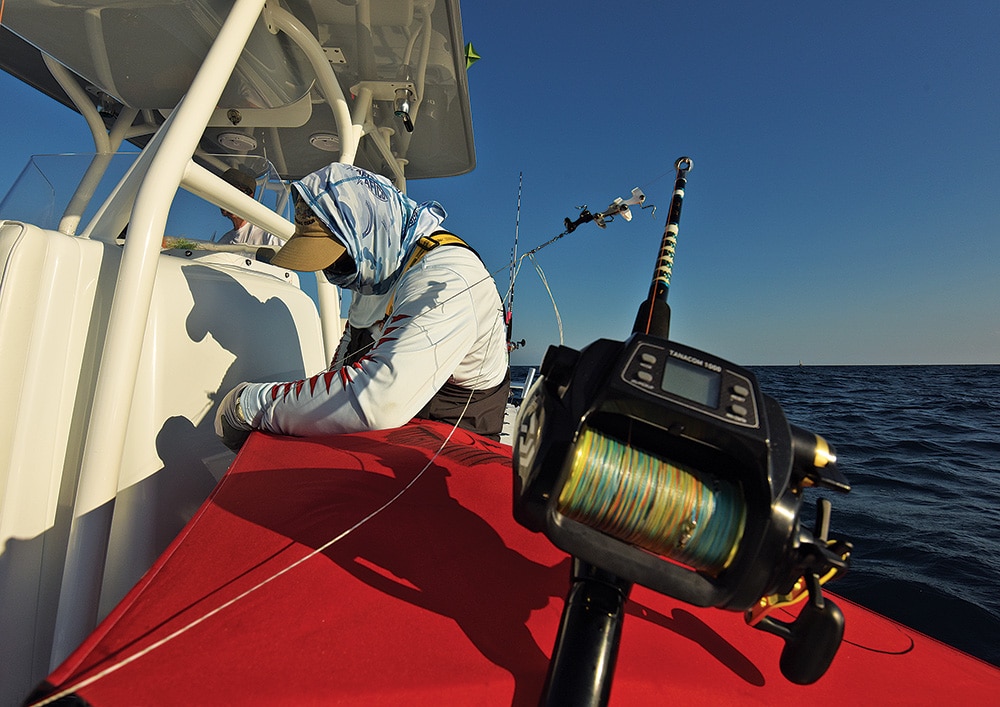
Possibly the most important prep for the tournament was acquiring baitfish each morning. Some teams go out and catch bait the night before a day’s fishing, but Towe had a reliable bait guy who drove to the docks each morning with goggle-eyes and threadfin herring. He drove all the way from Miami, proving that quality bait might not exist where the tournament’s happening. But buying bait is not cheap, with a dozen goggle-eyes going for $70 to $80. We had 50 of each species in their own livewells each morning when heading out.
When the Fishing Tournament Begins
Towe spelled out our tournament sailfish strategy each morning as we drove to the boat. His key strategies helped Kurz and me as we fished over two days. The quick crash course helped make sure I didn’t lose a sailfish when the opportunity presented itself.
My first sailfish strike was straight out of Mutual of Omaha’s Wild Kingdom. The sailfish exploded from the water, shaking its head like a spring-loaded bobblehead. I watched as the sail relentlessly tried to unhook itself, doing its best wiper-blade impression.
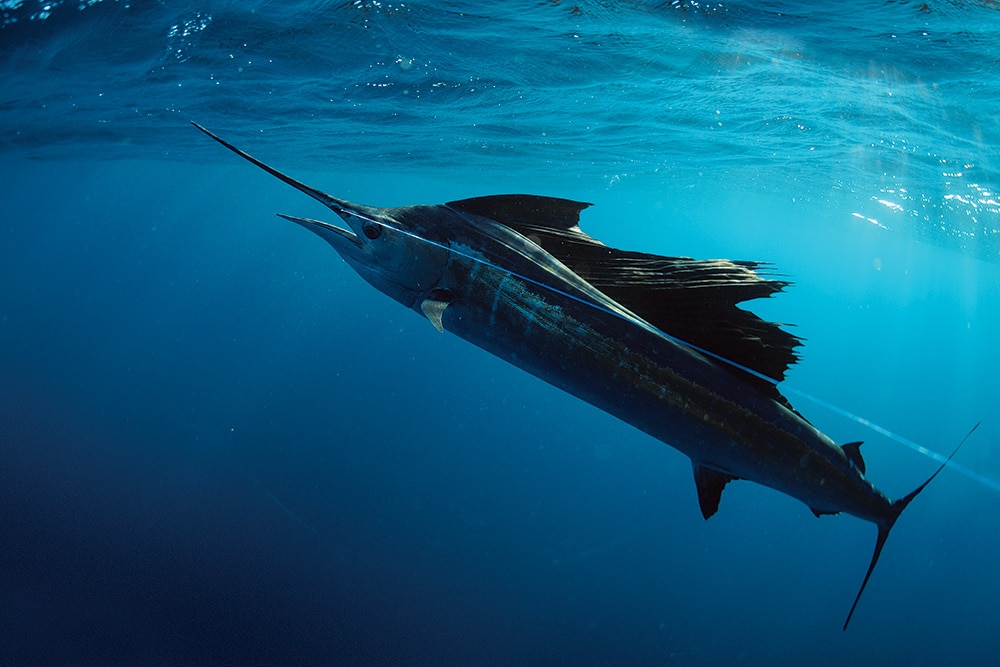
I made sure not to mistakenly reel tight on the sailfish too early.
“Only when that sail stops shaking and then swims away from the boat or against the line [should you engage the reel],” said Towe. Don’t push the reel to strike and start reeling until tension is felt from a fleeing sailfish, he explained. That instinct to fight back against a panicking sailfish is strong, but having the patience to slow the hook-set process pays dividends.
The same tactic worked for the kingfish we caught as bycatch, with kings skyrocketing 6 feet out of the water on our baits. Don’t reel tight while they’re airborne. Instead, wait until pressure is felt to allow the circle hook to take hold.
“Double or even triple hookups are almost necessary to win a tournament. Sure, single sailfish bites happen, but more often sailfish feed in numbers.”
When one fish was hooked, Towe and Morrison made sure the other angler was intently watching and constantly tweaking his baits’ positions. Kurz hooked up to the very first fish of the day, and he went to the bow of the boat to fight it. Towe, at the helm, bore down on the sailfish. Morrison brought in Kurz’s short bait and then followed Kurz, preparing to leader the fish. I stayed faithfully at my trident rod holder, with kite reel and two lines. The kite danced in the air, causing my baits to fly from the surface if I didn’t let more line off the pair of reels.
I wanted that double hookup to happen so badly, but it never materialized. Kurz fought his fish to the boat, and Morrison grabbed the leader, then gave it a quick pull. With light 20-pound line and thin wire hooks, one of three things happen when a sailfish is leadered: 1. The knot breaks at the hook; 2. The thin-wire hook gives, bending just enough to pull free from the fish; or 3. The hook holds strong, requiring someone to grab the fish’s bill and clip the line. Any one of these three outcomes happens in a matter of seconds, allowing anglers to get back to fishing quickly.
“Double or even triple hookups are almost necessary to win a tournament,” says Towe. “Sure, single sailfish bites happen, but more often sailfish feed in numbers.”
Tournament teams do everything possible to make multiple hookups happen. If both Kurz and I had hooked up to sailfish on kite baits simultaneously but a third fish swam within range of the boat, one of us would have put our kite-fish rod in a holder and thrown a live bait out to the sail in hopes of enticing a third hookup. Get the bites first, then figure out how to get the sailfish to the boat.
Kite-Fishing Tricks
After those first three sailfish in the morning on the first day, fishing slowed for us. I was feeling a bit too cocky, and tournament karma caught up to me. In fact, ocean conditions worsened throughout the day and tested the entire team’s patience.
A front moving south across the state brought a wall of wind and rain that hit us early that Saturday afternoon. At one point, I watched one of the kites catch a gust of wind and launch our port electric kite reel straight out of the boat like a javelin. I’ve never seen anything like that in my life, with the rod releasing from the rod holder and the cord escaping the boat plug. Somehow, the kite remained in the air and Towe maneuvered the boat to the vertical kite line. Inch by inch we pulled the kite line in and retrieved the dunked reel.
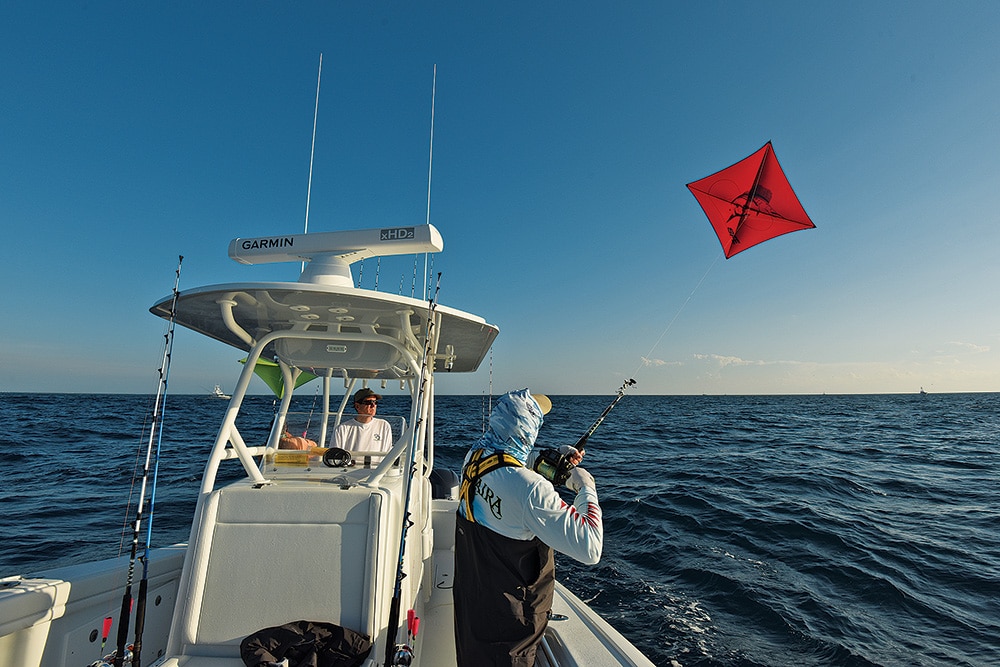
Later on in the day, another gust of wind snapped the 65-pound-braid kite line, setting our kite free. It landed near another boat, which managed to save it from Davy Jones’ locker. Around the same time, a kite from another tournament boat fell out of the sky and landed on top of some of our kite baits. We had to cut his kite free from our lines. This is the type of calamity that can and will happen during a tournament.
The whole second day might be better called the kite nightmare, or “kite-mare.” The main body of the front was upon us, with frequent 30-knot gusts. Towe remarked, “Most anglers simply wouldn’t go fishing on a day like this, but tournament anglers don’t really have a choice.”
After heading out to deeper waters off Carysfort Light, Towe and Morrison started the process of getting our kites deployed. Packed away were the kites from yesterday, and instead out came the burliest ones we had, meant for 20 to 25 knots and punched with holes to allow more airflow.
But each new deployment ended in failure. Whether it was a kite flying one second and speeding into the waves the next, the kite line snapping from heavy winds or kites folding in half midair after the spar snaps, kite-fishing wasn’t working for us. The frustration was palpable as we washed down the dunked kites with fresh water before drying them off inside the center console.
Eventually, we gave up kite-fishing and slow-trolled four baits instead, but it simply wasn’t the optimal presentation. Nearby, Pisces caught six fish, with us getting a front-row show. At one point, they connected on a triple hookup, landing all three fish.
“That’s the difference with a dedicated tournament-fishing team,” says Towe. “They have kites and kite reels for every situation. If the wind drops, they have kite reels with lighter line spooled on, ready to deploy a light-wind kite. Heavy winds? They’ll pull out the 30-plus-knot kites and reels packed with heavy braid. No wind? They have helium and balloons ready to fly kites. The costs of gear for tournament fishing [can be prohibitive].”
After catching just one fish the first day, Pisces shot up to first place to take the tournament, with seven releases total. We stalled out, tied at fourth place, with three releases all weekend.
Writer Theodore Isaac Rubin said, “Happiness does not come from doing easy work but from the afterglow of satisfaction that comes after the achievement of a difficult task that demanded our best.”
Although our team didn’t place in the tournament, I felt accomplished that our small, improvised team battled some of the best sailfish tournament teams around. And you can bet your bottom dollar, I’m already preparing for my next exciting tournament-fishing adventure.
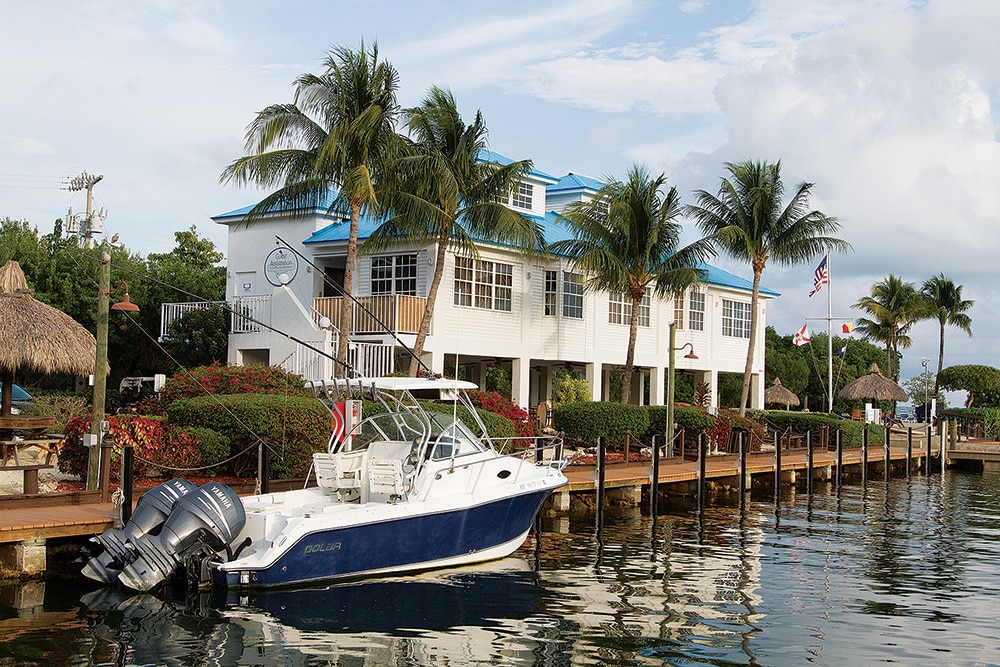
Where I Stayed for the Tournament
Ocean Pointe Suites is ideally located in Key Largo, off mile marker 92.5. I spent most of my time fishing while visiting the resort, but its amenities were still exceptional, including a waterfront cafe, heated pool, private beach and Mermaid Bar. A private boardwalk and marina, with a boat ramp capable of handling boats up to 28 feet, makes the spot a perfect option for anglers and their families.
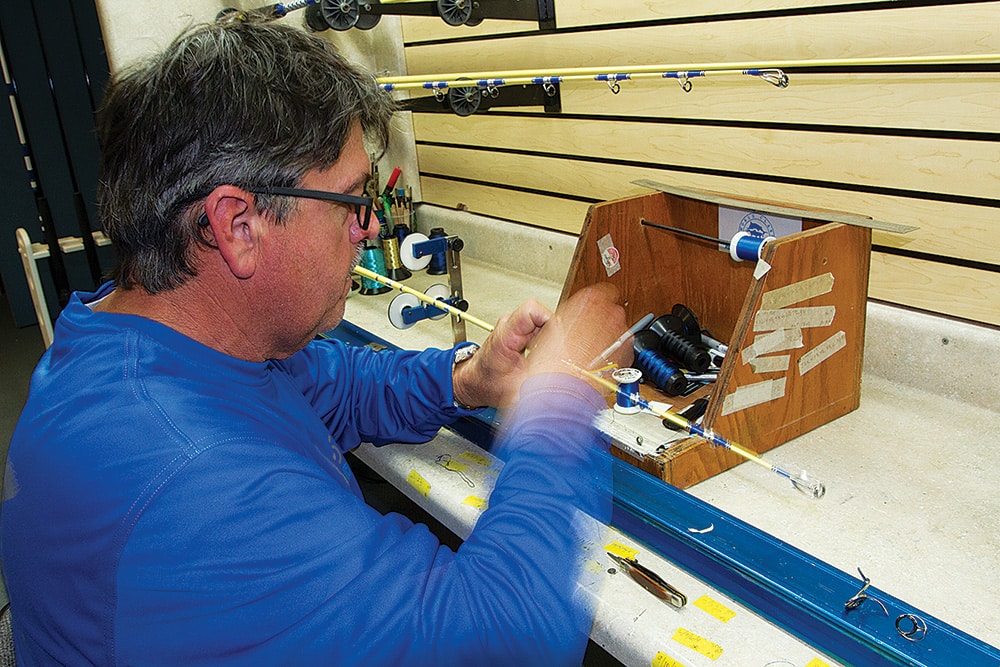
You Might Need a Fishing Team Coach
Capt. Randy Towe was the coach of our fishing team. Chances are you might need one too if you plan on jumping into the tournament arena without building a team from the ground up.
Growing up in Fort Lauderdale, Towe’s fished his entire life in South Florida and has been a guide for decades. Offering both inshore and offshore trips to clients, he’s on the water more days than on dry land.
Besides charters, he’s dialed in to the tournament scene, guiding the winning angler six times in the Don Hawley Tarpon Tournament, totaling at least 30 backcountry wins and more than 20 offshore tournament wins over his career.
When on land, you can find him at his custom-rod-building shop off U.S. Highway 1 in Tavernier. There, he wraps and builds quality, handmade rods, often for the same pro teams he fishes against in tournaments. He likes to joke that when a tournament team he’s outfitted beats him on the water, he’s still had a part in that team’s success.








